12.04.2009
FTC and Avon
"I made a million bucks using this."
Or, "I lost six tons eating this."
Or, "This is the best blog ever."
...well, if that's not what most people can expect, you have to take it down or clarify emphatically. Something like:
Bob made a million bucks. Most people make $6.23.
Sally lost six tons. The average weight loss is 2 ounces.
Luke thinks this is the best blog. Google doesn't agree.
That kind of thing.
The FTC said that this isn't a double standard. No. Instead, regular media is already held to this and it's those pesky bloggers who have been getting away with all kinds of nefarious things...
Well, I was in the bank today and I saw an ad playing on one of the screens. It was for Avon. The ad was very similar to this one.
Just a subtle, "It's possible you may not make 800 bucks in the first few weeks." No mention of "typical" or average results at all.
Why?
Because explaining why this testimonial doesn't apply to you in a 30 second commercial would mutilate your sales pitch.
I see a huge double standard.
I'm happy that the FTC looks out for lies and fake testimonials. Keep that up because lying should not be an acceptable sales technique. But it's utterly ridiculous to render true testimonials so ineffectual--especially if you're only going to crack down on bloggers and webmaster who leave comments on their site.
~Luke Holzmann
Your Media Production Mentor
11.21.2009
Pet Peeve: Enhancing Images
What to do?
The obvious answer is to take it to a lab and have the image "enhanced." After a lengthy process, the computer finally spits out the spitting image of their Uncle Mort, who is then arrested based on this incredible technological proof!
As exciting as such a string of events can be, it is horribly inaccurate and a total cop-out for writers who don't understand technology.
So, I give you this:

Pet Peeve: Enhancing Images
I'd love it if I could throw together a sketch and then let the computer construct a perfect image of Camilla for me.
But that's not going to happen. Even if I gave my computer two weeks to do it.
<sheesh>
My computer can't even render four hours of HDV footage for web delivery in that time frame. There's no way it could take my Picasso and turn it into a Rembrandt.
~Luke Holzmann
Your Media Production Mentor
11.09.2009
The Life Within
A few days ago we got to talking about Final Fantasy: Spirits Within which came out a good six years earlier than Beowulf.
Here are my impressions after watching the DVD. I had seen the movie once before in theaters...

Aki's Eye
Good skin detail. They added freckles because perfectly smooth skin looks plastic. Overall, the motion was better than the modern stuff, but there were still many places where it felt like I was watching my wife play Sims 3 rather than a ground breaking animated film.
Also, hair just wasn't very good back then. They really worked hard at it in a few key moments, but it still wasn't anywhere near that of Sulley in Monster's, Inc. I'm not blaming Square, considering Zemeckis hadn't improved on their look.
The other major problem with "photo-realistic" animation is that objects just don't interact with each other properly. It just didn't feel like they were connecting in the kissing scene. Rather, they looked like two puzzle pieces that didn't quite fit.
Unfortunately, the DVD quality was horrible. For a movie that was originally rendered on a computer, having the image grainy and washed out is simply unacceptable. Also, I think the sound was a few frames off which can also happen when you have poor compression. Both of those facts made it really difficult to judge the quality of the animation.
Was the lame fire effect because it was made in 2001, or because the DVD was put together so poorly?

Fire
I'm pretty sure that primitive particle engines--that fling dust and debris around virtual space--are part of the issue. But the bad compression certainly didn't help anything.
The lesson? Your movie can be "hurt" at every point... even when you put it onto a DVD. So be careful at each stage.
~Luke Holzmann
Your Media Production Mentor
10.18.2009
Literal Music Videos
And the music video is super wicked cool too. Of course, I've long been a fan of the Vampire genre, and this seems to fit nicely with more modern tellings of Stoker's story.
But now check out the Literal Video Version:
Meat Loaf: Literal Video Version
I absolutely love these kinds of creative projects. There are so many good film terms used. And, honestly, you begin to question why anyone thought this made sense. And it totally cracks me up because... yeah... they're right. If we were to take the video literally, we'd be laughing rather than rocking out.
Here's the thing to remember for your productions, though: The original music video still rocks. So even if you can epically poke fun at a production does not mean it's not good in the original context. How it Should Have Ended proves that with major blockbusters all the time.
Of course, there are some really odd music videos out there. Things like "Total Eclipse of the Heart" which... well...
The literal video version is much, much better. At least, it makes more sense:
Total Eclipse: Literally
Okay, okay... for those of you who aren't as up on awesome '80s rock, check out the literal version of "Penny Lane" and think about it: Music videos are really, really odd at times.
~Luke Holzmann
Your Media Production Mentor
10.17.2009
Deja Vu

You Can Save Her
I realized two things this morning while the girls were playing with the fridge magnets:
- The letters would not have been on the freezer portion of the fridge because that is out of the reach of children who would play with these letters.
- Claire has a kid... but he comes and goes as needed.
Suspension of disbelief is required even for great films.
~Luke Holzmann
Your Media Production Mentor
10.14.2009
Bad (film) Grammar
First, it's Battlestar Galactica all over again. Many of the exact same characters just with different actors. Same plot points. Same story arch. Same conflicts. Same shooting style. Slightly more Myst-esque lighting. Some really terrible acting (which Battlestar mostly avoided).
But the makers of SG-U have used terrible film grammar in several scenes.
The grammar of film has to do with the accepted meanings of certain shots. Use the wrong one at the wrong time, and you'll confusing you audience. ...er: confuse your audience.
Throughout episode 2, there are moments when the camera goes to an angle or position that, grammatically, says, "I'm someone watching the actors from the shadows" but thus far they have done nothing else to indicate that these were nothing more than "artistically interesting" angles.
Example one:

Someone is hiding in a crevice watching
This camera position tells us that someone is watching this conversation without anyone realizing it. Someone, or something is on board the ship without anyone's knowledge.
Example two:

Someone is hiding in the ventilation shaft
Seen through a grating or some other shaft, a spy is looking down from above. That is the standard interpretation of this angle, framing and camera motion. But the next shot is back to normal with no indication as to why they may have gone into the rafters to get this take.
Example three:

The watching eye
A security/surveillance camera would take a shot like this. But this is not part of a security or surveillance system. Perhaps the editor failed to include the "grimy" filter they put over the roaming camera balls aboard the ship, but I don't think that is the case. This shot is wrong for even that (wrong position and static).
The lesson: Do not break the rules of film grammar just to get a pretty/different shot. Mixing things up is not worth mixing up your audience. It is far too easy to send the wrong message with an improperly used camera angle. So plan and think about your shots. And if you're editing the show, don't use 'em just because they look good.
On the other hand, if you are trying to communicate something subtly with your angles, you need to provide more than just a few glimpses now and again. Subtlety is not the same as cryptic hints. Subtlety allows your audience to slowly connect the pieces and get excited with you. Cryptic hints merely frustrate or confuse, and ultimately detract from your payoff.
~Luke Holzmann
Your Media Production Mentor
10.08.2009
Spending that Much
He wrote back and said, "Hmm....I wasn't thinking of spending that much."
...
He then went on to tell me that he didn't need a "professional" shoot, that he didn't need fancy special effects, and figured that there'd be "little to no editing" required and that an hour should suffice for his needs.
It took me three days to get back to him because, well, I couldn't figure out how to say it nicely:
I didn't base my quote on how much I thought you'd like to spend!
I based my quote on my understanding of the production process. I've shot this kind of thing many times and have a pretty good handle of what's required. And, hello: If you shoot for an hour or two, you will need to edit it to make it your requested 15 minutes in length.
Have you done pre-production? No? Well, that's more stuff I'm going to have to help you do. Seriously: I'm not going to sell myself short just because you are completely ignorant of the production process and so think I've got to be overestimating this.
And if you don't want a professional, need no editing, and figure you can just set up a camera and shoot: Please, by all means, get your Uncle Earl to produce the video for you. If what he creates is what you want: Fantastic! We've both won.
If not, then next time you ask for a quote, remember that you're asking me.
I ended up suggesting he watch the video linked through this post.
He wrote back and confessed that he didn't know much about the production process and realized he had made some false assumptions. He said he'd get back to me.
He hasn't yet.
~Luke Holzmann
Your Media Production Mentor
10.05.2009
Why the DSLR Video Camera Now?
It's been pretty crazy to watch the explosion in this area of technology. When I entered college, DVD burning was not yet an option. Three years later and you could burn as many DVDs as you wanted on a reasonably priced laptop. Video web compression went from a 120x240 Ream Media file to today's common video sites streaming HD Flash footage for free. And back in my day, you had two options for video: Stand Definition and Uncompressed SD.
Now, my pocket camera shoots HD footage and lets me drag it into YouTube with pretty good results.
But why, someone asked me, are digital still cameras all the rage these days? Why are they shooting HD and surpassing many of the video cameras of just two years ago?
Why indeed.
I think there are three reasons:
- Larger sensors: Digital cameras have long had larger sensors than their video counterparts. Larger sensors give you bigger/better images.
- History of flash media: Granted, the first digital cameras captured to floppy disk, but rather quickly switched to solid-state memory. This long preceded Panasonic's P2 hype, and now that flash memory is so cheap and wicked-fast, the Digital SLR is the inexpensive, proven, open option.
- Do it all: I have a $10,000 HD video camera that rocks. But it's stills are hardly even a megapixel in size and not very good. For a couple grand, on the other hand, I could have a camera that shoots at a higher resolution in video and takes gorgeous stills.
I'm sure there are other reasons that have to do with lenses, accessibility, price-point and all that. But the three outlined above, I think, made the rest possible.
So will I get myself one of these beauties?
Not yet. But they sure look like a great option.
~Luke Holzmann
Your Media Production Mentor
9.25.2009
Wake Up! This Isn't Hard
My manager continues to push articles my way and ask my opinion on the latest ideas from marketing "gurus" who pretend to know how to use social media to make oodles of money. Most of the articles reaffirm that I'm on the right track. A couple actually contain a new twist on how to get involved in the "new media" that is rocking the marketing world. So, it's fun to read these articles, smile and nod, and then rant and rave when they get something horribly wrong.
But in all honestly, the concept isn't that hard.
Let me give you a very clear, easy to remember and apply example:
You are a major brand interested in getting your name out there. You spend millions of dollars on market research, hundreds of thousands of dollars on producing a carefully crafted commercial which is then meticulously placed in a time slot that matches your ideal customer's demographics.
Multiple millions of dollars later and you've got a great commercial that speaks directly to your target audience and makes them daydream about your product in the shower. In fact, the commercial is so successful, your target market is dying to share it with their friends.
You have heard about this wildly popular "new social media" thing that some companies are using very well called YouTube. So, you spend tens of thousands of dollars setting it up and making it branded with your fancy logo and other specialty components that some no-name Luke guy can't replicate. This sets your YouTube profile page light years apart from the rest of the crowd.
And then you only upload three commercials to your account... none of them the excellent ones.
Oh, but you do have a clip of Lindsay Lohan saying she's having fun at one of your social gatherings.
...you've got to be kidding me.
Of course, I shouldn't be too hard on you. I mean, it's not like your website works either:
Website Fail
So, for the rest of you out there interested in how to use social media, do this: Post every single halfway decent commercial you produce on YouTube, or Vimeo, or your own site even. Just make it possible to embed (or at the very, very least: link to) your commercial.
If you did that, I'd have four to six of your commercials in this blog post right now instead of a posting about how much you've completely failed.
<sigh>
Now I feel like I should offer my services to them as a consultant. They need me.
~Luke Holzmann
Your Media Production Mentor
9.18.2009
Tutorial: Isolating Colors in Gimp
First, you'll want a picture that has a lot of color so the effect will be noticeable and cool. If there aren't a lot of colors, it will be far less impressive. So, I found a nice patriotic picture I took with reds, greens and blues.

Flags
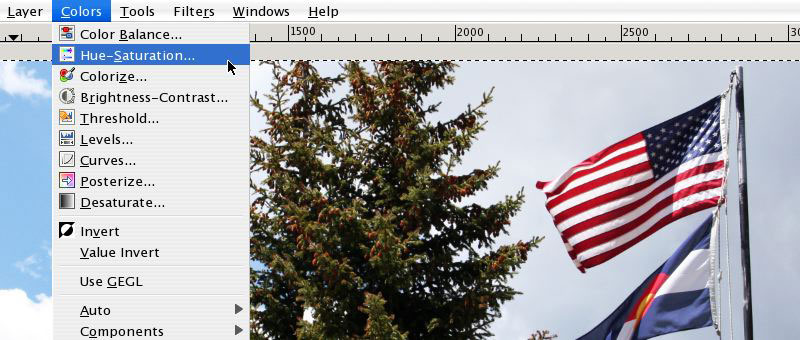
In Gimp, go to Colors->Hue-Saturation...
Select the B (Blue) radio button and drag the Saturation level down to -100:
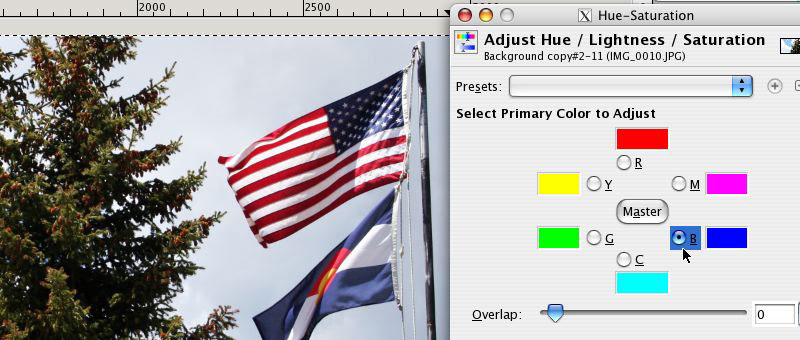
Blue Radio
Notice how the blue is now gone from the flag, but the sky is still blue. What's going on?

Still Some Blue
Well, the sky is actually more Cyan in color than Blue, so you'll need to select the C (Cyan) radio button and also get rid of the saturation for that color as well.

Desaturating Cyan
Repeat this with all of the colors except the one you want to keep:

Only Red
But wait, there's some red in the tree! That's no good. So duplicate your color isolation layer by dragging it to the "Duplicate Layer" icon:

Duplicate Layer

Go to Colors->Desaturate...
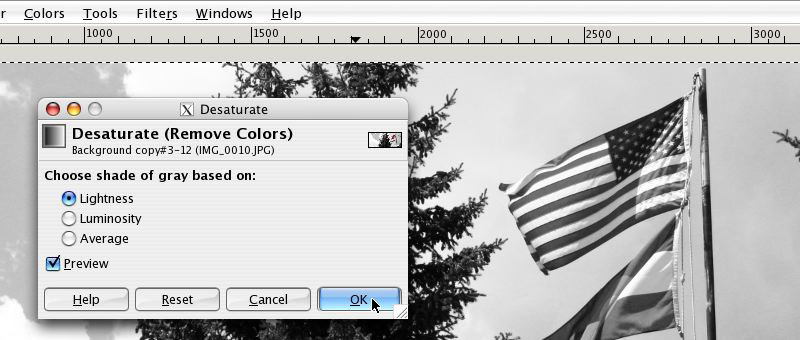
And pick one of those options: Ok
Now your whole image is black and white, so select the Pen tool and draw a path (by clicking on various points) around the flags. You don't need to be too careful here because you only need to keep the red parts of the flag.
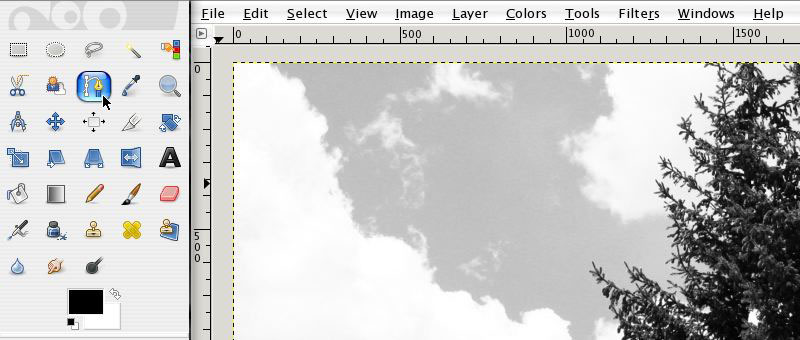
Pen Tool
Again: The pen tool doesn't really draw on your picture. It merely creates a "path" that you can use for several cool things. But one of the most useful is creating custom selections. So, once you've made it around your object, right click and choose:
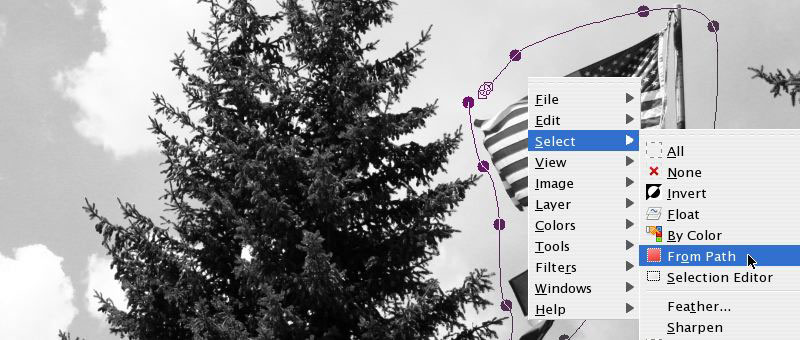
Select->From Path
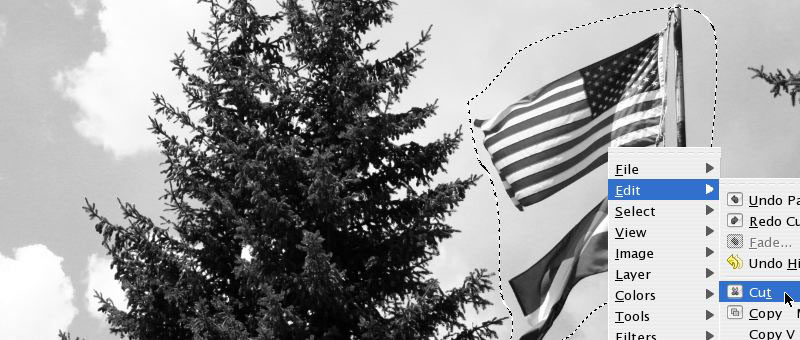
Right click again to Edit->Cut

Wait... what?
Why is there a big while spot? Shouldn't the selected area have gone away?
Yes, it should have. But if this happens to you, right click on the layer in the layer box on the right you want to cut out and select:

Add Alpha Channel
Now when you cut or delete something the Alpha channel will make that part transparent instead of white.
And you're done!

Flags with Isolated Red
~Luke Holzmann
Your Media Production Mentor
9.17.2009
Why Isn't Sony Winning?
Granted, I haven't been a big fan of Sony since that day in film school when I tried to capture a MiniDV tape shot on a Sony camera that wouldn't play on my Canon.
Made me angry.
But I know people who have sworn by their cameras, own their computers, use their software, play their consoles, and I've even watched some of their movies. And as I flipped through the catalog and noticed that they make everything except an operating system, I asked myself: Why isn't Sony winning?
I read part of a book that praised Sony for their business acumen, solid practices and even great products. So why don't we hear about them? Sure, a few of their products are commonly mentioned, but never with the brand.
PS3
Do you ever hear someone talk about the Sony Playstation the way people mention the Apple iPhone? Why the brand disconnect? And why isn't Vegas mentioned more often? From everything I hear, the software works great and is dirt cheap.
Curious, especially after Apple's continued rise, I googled "Sony profits" and found article after article that talked about the 90% decrease they had in 2008. I can't imagine this year's going much better.
Just like Apple, Sony makes hardware and software and is proprietary. They have their fingers in much more than Apple producing major gaming consoles, movies as well as cameras, phones, mp3 players and more.
What is Sony missing?
It's not the OS. Windows is on far more computers.
Are they missing a hip brand? A development platform? An "it" gadget?
I thought writing this out would give me some clarity and a guess as to the answer. But it's not. I can't figure out why Sony isn't winning...
~Luke Holzmann
Your Media Production Mentor
9.04.2009
Stuff I'll Never Learn: Modding
And I don't have the patience or the time for that. I have plenty of other things to do. Yet, given eternity, there are things I'd like to do.
Like learn how to build 3D objects and meshes to mod the Sims. So, I poked around for a while today and started reading some meshing tutorials.
I was following along just fine until I got to the part where he started talking about how you can make "65,536 different values into just 16 bits, while the floating point numbers I talked of before take 32 bits [so] we can define each face using 3x16 bits and sharing locations instead of using 9x32 bits each."
Umm... okay. Yeah.
I think this has something to do with what he was saying about using triangles as the base shape for all game polygons, but... <cough> yeah.
Thankfully, this set of tutorials seems a little more hands on. But, again, this would take years of practice before I got to the point where I could do what I want to do right now, so I don't think I'll ever get very far.
~Luke Holzmann
Your Media Production Mentor
8.29.2009
8.21.2009
Inspiring Creativity
Do You Wanna Date My Avatar
Of course, it can also be depressing because here's a bunch of talented and creative people working together. And people like us? Well, we're alone. And it's hard to do major productions when it's just us... especially if, like me, you can't play music, can't dance, can't act, and struggle with coming up with a great story--not to mention find time in your busy life to put something together.
And that's why I'm in favor of a limited application of illegal derivative works.
Things like this:
Anime Music Videos (AMV)
These kinds of projects let you practice crafting a story--though editing--based on a "script"--a song's tale--while using really quality elements--great animation of things blowing up and professional mixed music--that you'd never be able to make on your own.
Also, the good fan flicks use backstory and themes from the original series to spin things in a while new way, like this one*:
Kyo Will Make A Man Out Of You!
I think these kinds of videos should become legal to post as well because sharing projects like these with the world can inspire others to try their hand at creativity.
~Luke Holzmann
Your Media Production Mentor
*If you haven't watched Fruits Basket you should, and this video will be so much better if you know the inside jokes.
8.13.2009
Printing Pictures
You go through your pictures and find an awesome one from a recent camping trip you went on. You do a little tweaking to get it looking just so, and you're ready to go.

Hot Dogs
You take your flier file to your nearest CosWalKo's, stick the CD/jumpdrive/flash card into the reader thingy, request 5,000 prints, and pay the nice person behind the counter who informs you your prints will be done in two hours.
...
Two hours later and all your prints look like this:

Not So Hot Dogs
The grill now looks teal instead of black, the dogs are more yellow than meat, and the whole thing is worthless now.
Lesson 1: Before any print job, do a single copy just to make sure. These proofs are essential. And it's a good idea to ask for one in the professional world too (even if the duplication house balks at the idea, make 'em give you a proof copy anyway).
Lesson 2: What you see, is rarely what you get. And there are sevearl reasons for this:
- Every screen is different. Even if it's made by the same company, one screen may be lighter or more blue. There are ways of calibrating monitors, but most of us can't do that and wouldn't know exactly what to do if it was "right" anyway. And if screens can be different, there can be huge variation between what you see on your monitor and what comes out on paper.
- The "color profile" is different. Your computer screen images are made up of Red, Green and Blue pixels (RGB), but printers use Cyan, Yellow, Magenta and "Key" [Black] ink (CYMK). While modern technology has made it relatively easy to switch between these two "color spaces," things can be lost in translation. And if you don't translate, the printer has to guess how much Cyan and some other color it needs to mix to make your Blue.
- Physics. What you see on your monitor is created by photons emitted from your Liquid Crystal Display (LCD). What you see on a piece of paper are photons bouncing off a specific ink that reflects only a certain part of the color spectrum of light. This huge variation makes it really hard to match darks and lights because one is active and the other passive.
I'm sure there are many other difficulties in all of this--ink and printer quality, software used to interpret the image, paper type--but suffice it to say: Getting a match is really, really hard.
So what can you do about it?
Lesson 3: Shop around. My best friend, when he was trying to find a printer for the photos he meticulously adjusted, sent the same six images to five different printers. Then he compared the prints to what he saw on his computer. By doing this simple experiment, he was able to disqualify three of the printers because the images weren't sharp enough. And after carefully looking at the colors, he decided that one of the printers more closely matched what he saw on his screen.
But even then, it wasn't perfect. He ended up having to always tone down the yellows in his "final" images so they'd look right in print.
~Luke Holzmann
Your Media Production Mentor
8.08.2009
This is How They'd Remind Me...
This put me on a quest for this audio file (because it wasn't linked in the incredibly short "show notes"). This page indicated that there may have been some editing involved, so I dug deeper. Google finally landed me here which includes links to both the song and an NPR article on the subject. It turns out that editing was involved, but that doesn't make the combination of these two songs any less impressive or incriminating.
Nickelback isn't the only group to have similar sounds show up on their albums. Angels and Airwaves has several songs on their debut album that repeat each other (though I am not skilled enough to match them up without many hours of work, not to mention the copyright issues; sorry).
So, what's the difference between these incredibly popular artists and today's worship music that contains about the same number of chord progressions?
Mixing and complexity.
Good bands tend to have slightly more to offer than a couple of guitars, a bass and a piano all playing the same three chords over and over again. Plus, they are often much more subtly mixed and therefore more blended. Which isn't surprising since they spend hundreds of thousands of dollars to get their sound and people like me mix the morning worship set.
And for as much as I'm amused by repeated sounds, it doesn't get much better than City on a Hill where two songs start with the exact same words on the album... twice (tracks 4&5, and 11&12).
~Luke Holzmann
Your Media Production Mentor
8.07.2009
Graphics Cards
And now I have a slighter better idea.

New and Old Graphics Cards
These cards have more than just Graphics RAM--the extra space dedicated to providing space for giving your pretty pictures. They also have image processing power. The problem is that this number is not made public on the boxes.
So, look for the RAM size and speed (1gig DDR2 vs. 512 GDDR3...), but if you can find out the difference between the 4650 and the 4820, or the 9600 and the 9720, you may discover that the $200 swing is due to the number of processes it can handle (320, we were told, is pretty good for our price range).
<shrug> Who knew?
What to learn a little more? Check out the How Stuff Works article on the subject of Graphics Cards.
~Luke Holzmann
Your Media Production Mentor
7.10.2009
Pasted Plastic and Liv's Nose

Liv's Nose 1

Liv's Nose 2
Nothing particularly interesting in this observation, just something that kept happening again and again.
The other thing that kept happening in the movie was that every time Hulk was in the frame, I got pulled out of the film. There was something very wrong with him. And what struck me was just how plastic he looked. Every frame made him look pasted in.

Hulk Pasted In

Plastic Action Figure Hulk
Part of it is lighting. He just doesn't meld well with his environment (even though the lighting effects blend well between the background and him). But another major aspect of his plasticity is, I think, his eyes:

Hulk's Eyes 1

Hulk's Eyes 2

The Incredible Luke Hulk
~Luke Holzmann
Your Media Production Mentor
7.09.2009
The Fuzziness of 24P
Granted, most of the time I don't even notice, but fans and camera motion give it away. Like this shot from the opening of The Incredible Hulk:

24P Blur
This beautiful camera shot is completely ruined by the fuzzy/blurry image that 24 frames creates. I don't care how "high rez" the image is, if it's blurry then the resolution doesn't matter. In fact, it looks much better squashed down to fit in this post than blown up on an HD screen because of the way the blurriness detracts from the image resolution.
The lesson?
I don't remember who said it first, but he was absolutely right: If the image is out of focus then it isn't HD.
And motion blur is very similar to an out of focus shot.
So don't buy into the hype of 24P or HD if you can't get a good image from it.
~Luke Holzmann
Your Media Production Mentor
7.03.2009
Cloverfield, the 2000 Edition
[Aside: The same could not be said for The Happening which did nothing for me at all and consisted of acting on par with 10,000 BC, only without Camilla Belle to make up for it.]
But I just realized that Cloverfield was a remake of a 2000 music video, only they just added monsters this time. That's right, Cloverfield looks and feels just like Eve 6's Here's to the Night. Don't believe me? Watch the music video.
See? Deja vu.
Almost as creepy as the monster. Almost...
~Luke Holzmann
Your Media Production Mentor
6.18.2009
Licensing Photos
And if there's someone in the picture, you need to make sure the photographer has permission from the models so you can use their image in your project.
But pictures of yourself?
Knock yourself out. If you want to be crazy and post pictures, go for it. Though, you may want to be careful. And if a family member decides to take a sweet picture of you, you can probably post that too without too much concern.

My Family Hiking
But here's the kicker: Your Senior Picture, family portrait, wedding photos... nope.
You are not allowed to post those online. You don't own them.
Crazy! I know. They're of me, for crying out loud! I hear ya. I paid them hundreds--if not thousands--of dollars! You're right. I bought these pictures, so they're mine!
Wrong.
When you pay a professional photographer to take pictures for you, you are paying for their time, their work, and a license of the images. That license may include web distribution, reproduction, and extra printing... but probably not.
Why is this important?
Well, it means you can't legally take a picture of, say, your firm's president from a recent family portrait session and use that image on your firm's advertising materials.
Hypothetically speaking, of course.
First, you need to purchase all the rights to the image for a few hundred bucks, and then you're good to go.
So, remember: Just because the image is of you, you may not have the right to reproduce it or share it. You may only have the right to look at it--courtesy of the wonderful thing called "licensing" within media law.
~Luke Holzmann
Your Media Production Mentor
6.16.2009
When Killers Die
Duh.
But at a certain point, very early on, it also gets old. Like, in the case of all the "killers" that come out. In fact, there are so many "killers" that I feel like we're not human at all anymore, but rather dancer [sic].
Red, the P2 Killer. Android, the iPhone Killer. Blu-ray, the DVD Killer. Silverlight, the Flash Killer. ...on and on...
What's interesting to me is that thus far none of those have killed anything, and none of them have really taken off.
So imagine my reaction when I heard about Microsoft's Wii Killer: Natal.
[guys, it's not a good sign when your official homepage doesn't exist... just so you know. Thankfully, Wikipedia has you covered]
Actually, it's very cool technology (if it works). Their demonstration (sorry, the person added some very lame annotations to the video--including an f-bomb) isn't very good--they need a better speaker and a more polished presentation. Their trailers aren't all that credible, and we really don't know how well this system is going to work. But the idea is cool. ...except... Nintendo appeals to kids and grandmas who like racing cows, whereas Xbox appeals to people like my brother who like FPSs or games where you brutally rip people apart in a spray of blood.
Different market.
So how will Natal do?
It's really hard to say because of where it is right now (i.e. not here yet). But my guess is that this will be yet another "killer" that dies.
~Luke Holzmann
Your Media Production Mentor
6.15.2009
The Language of Computers
File->New
Edit->Copy
Shift Click
If you use computers on a daily basis--and I assume you do--then these all make perfect sense. Completely normal. Even the Escape Key is perfectly comfortable on your keyboard, though you've probably rarely found a use for it. But this normalcy is completely foreign to some.
This evening I went over to visit with a family from our church--their daughter is in our Sunday School class--to help the woman figure out how to put music and pictures onto her iPod Nano. Within the first few minutes of sitting down at her computer we had covered:
- The difference between a Folder and her Desktop
- Documents vs. Music
- User accounts
- Left click vs. right click
- Devices, hard drives, and media
- Folder sorting/organization
- and the iTunes interface
After that we showed her how to "import" music from her CDs, drag and drop them onto her iPod, and how to rename music files that did not automatically update. And I realized again that computers are anything but "intuitive". Rather, we learn where to expect to find things and can typically figure it out. As we encounter new programs and interfaces, these layouts shift and we have to go hunting again.
Left or right click? Well, is this a function that you want to activate or possibly alter/further define? How do you decide?
Why is it called "File" that ultimately lets you Open, Save, Create New, while "Edit" is where you Copy and Paste? I'm not totally sure. I mean, I get it, I do, but it's not the first thing people think of... unless they've been in computers for a long time.
And honestly, as I poked around the latest version of iTunes on a Vista machine, I felt a little lost now and again. 'Where did they move that feature now?' I found myself wondering every now again. 'I know where it used to be...' And so I'm lost as well, but I just happen to know roughly what I'm looking for.
~Luke Holzmann
Your Media Production Mentor
6.11.2009
It Cuts Both Ways
The scene was mostly closeups on the boy's face as the coffin moves in the foreground:

Coffin
The pallbearers move on toward the waiting hearse.
But wait, the coffin is moving past the boy again.
Huh?
This scene is horribly cut! They are repeating action in the cutting. I can't believe how shoddy the editing it for this scene. You've got to me kidding me! I mean, here they are putting the coffin into the hearse.
Cut to the pallbearers opening the hearse doors...
...wait...
There are two coffins?
Oh, that makes sense. Got it. Okay, not so bad anymore.
"Son," the man on the screen says, "I'm sorry about your mum and dad."
But the scene was bad. I was confused. I didn't know there were two coffins until they practically came out and told me. And if I wasn't slightly more astute, it would have taken until they said the line before I would have figured it out. And that makes it a very bad scene.
How could they have avoided this problem?
An establishing shot. And they could have had their pick:
- Two hearses in front of a church
- Two coffins in the viewing room
- A wide shot of the processional exiting the church
- The boy's POV of the two caskets
- A slightly wider angle of the boy so we could see what was happening
But no. The entire scene was close in, personal, an individual experience focused on emotion and loss. And because of that, the audience was Lost.
I think many student films suffer from this same "claustrophobia" in that we rarely establish our scene. Establishing shots are difficult to pull off--in fact, I don't think we ever talked about them in film school--but they are essential to give your audience context for what is happening and where.
And here, a major scene from an excellent show was ruined because they never gave us a glimpse at what was going on.
~Luke Holzmann
Your Media Production Mentor
6.10.2009
F Is For Font
Graphic design.
And with graphic design comes fonts. Fonts of every shape, size, style, and feel.
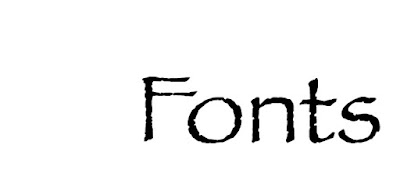
Fonts -- Yes, yes, I know
You have to buy fonts to use them--unless you can find them legitimately for free. But what can you do with them? What does it mean to have a "copyrighted font" at your disposal? I mean, if you read some of the legal documents it appears that all you can do it buy the font and look at it on your own computer and no where else (not even your other computer).
So I started digging. Here is what I have found:
- Fonts are technically "software" now which means:
- a) You can't give copies of it to others, or put it on another computer unless you have permission from the people who hold the copyright
- b) You can't modify the font or change the name as this would be like altering code
- c) You probably shouldn't embed a font into a document unless you're sure you're allowed to
- If you have any questions about what you can and can't do with a font, check the EULA (end user license agreement)
- Every EULA is radically different from all the others, so check the EULA if you have questions
- Seriously, no one can give any legal advice; the EULA is supreme
- ...it is impossible to find a copy of any font's EULA
Yep, that wasn't helpful.
Here is what I have concluded: If you have a license to use a font--and you do if you purchased a copy of Word, Photoshop, or paid for your computer's operating system (which is typically included in the price of your computer), or have downloaded a program/operating system legitimately for free (like a Linux distribution or GIMP), or have paid for a font you downloaded--then the following rules apply:
1. Do not share the font. Just like software and other digital media, you can't share, copy, or give away this font to anyone else.
2. Feel free to use the font. The big, scary copyright laws seem to have much more to do with protecting the font file, and less to do with how you can use that font file in your programs. For instance, yes, the EULA may say that you can't "modify the font" in any way--which would seem to imply that you can't take your Liquify tool and stretch the bottom of the "R" a little, but this is not the case. You just can't go into a font editing program, stretch the "R" a little and resave the font (as that would be a derivative work).
So, near as I can tell: Feel free to use the fonts in your programs however you like to make logos, header images, layouts, and other fun images. It is absolutely within your licensed right to do so.
~Luke Holzmann
Your Media Production Mentor
6.08.2009
Other Video Sites
With mixed results.
TeacherTube and HomeschoolViewTube are two examples of sites that are, well, floundering. These are niche sites that focus on a particular type of video to get people to congregate there. Here's the problem with these kinds of sites:
There's no need for them.
YouTube, which is more ubiquitous, will host these videos just fine. And then you have the power of Google behind you too. Not that you couldn't host your videos on these other sites... but it doesn't gain you anything to do so. Unless they took off. Which would require people uploading tons of useful content there. And, well, you just can't compete with YouTube's insane amount of content (I heard a rumor it was close to 24 hours of footage every hour... but I can't confirm that so it may just be web hype).
Vimeo, on the other hand, offers you a place to upload huge video files, and so caters to the filmmakers of the world.
Other sites of a more... <cough> questionable nature provide those videos that are not as readily accepted on YouTube. So those have a natural niche as well.
But these other video sites--like those mentioned above--offer nothing new. And that is why they are floundering with only a handful of clips.
~Luke Holzmann
Your Media Production Mentor
6.06.2009
I Am Not a Videographer
And I tend to like what I get after cutting an hour long event down to a few minutes of brilliance.
I am not a videographer. I've only shot two dance recitals in my life, and neither of them went how I would have liked. The first was a mad scramble to try to get everything set up properly and then grab some good shots from the back of the theatre--which, from my experience shooting weddings, is not the way to get good footage. In the end, I didn't even get the kinds of shots my friend wanted and the whole thing ended up almost completely unusable.
Which, going from a professional filmmaker to a worthless videographer didn't help endear me to the process.
The second event was last night. The location was over an hour and a half away and traffic was unaccountably slow. This meant I only had a few minutes to set up. I arrived and no one knew I was supposed to be there. My one contact was busy trying to get the event started, so I just did my own thing. I was told where I could shoot (which turned out to be great because I was right next to the sound guy who was kind enough to get me an audio feed), and the event just started. No warning whatsoever.
As a filmmaker, all of this smacked against my production values. Where's the "lights, camera, action"? Wouldn't it be good to check the audio feed before we get going so we know we have the microphones in the mix as well? We didn't. And, again, I found myself in the videographer's position: in the back.
I couldn't white balance between dances--where they change the light colors and throw everything out of whack. And I had no say over the color of the lights or the costumes--several times cherry red, which "bleeds" and smears on camera. I had no idea where the action was going to be next. And, honestly, since I haven't shot very many dance recitals, I found myself panning to the wrong place and missing the interesting action.
Oh, and the event was well over two hours long.
Six hours after I left, I was back home. I had footage I wasn't proud of, of an event that wasn't particularly interesting, with no focus on a particular person or event that an audience would want to watch again. Granted, I've been to dancer's houses when they've shown me their recital tapes. I realize that seeing the thirty seconds of themselves on a two hour DVD makes it worth watching the whole thing to them.
But me?
Editing is what makes dancing worth watching.
Sorry, this post drifted into my personal frustrations a wee bit much. Let me sum up. I am not a videographer because:
- I like to control my shooting environment
- I like to rehearse my shots
- I like to edit events down
- I like to be in the midst of the action
- I like to work with those I am shooting, not for them
- I like to know the equipment is set properly
- I like to adjust everything to get a better shot
- I like to be in control
- I like to like what I've produced at the end of the day
I have a new respect for videographers. They have a rough job, and I see now that it requires many hours of practice to get good at it.
But I'm not sure I'll ever get those skills because I hate not producing stellar footage for people in the mean time, and I hate driving to places I've never been (as I tend to get lost). It's just not worth the stress on my end, and the potential failure to get anything usable.
~Luke Holzmann
Your Media Production Mentor
6.04.2009
So You Think You Want This?
Actually, I tend to scare people off right away so this doesn't happen to me. I tell potential clients exactly how expensive it's going to be and that there are plenty of low-end videographers out there if they're just looking for someone to hold a camera and press record.
I'm not sure, but I think they tend to go that route--or sometimes take my suggestion that for that price they could ask their Uncle Earl to do it for them.
I find myself reminding people of the Production Triangle often. Sometimes they get it. Sometimes they don't.
~Luke Holzmann
Your Media Production Mentor
6.03.2009
Lost: Storytelling with Editing
We had just finished watching an episode of Lost, and don't worry, I'm not going to give away any spoilers if you're still catching up like we are. I had no idea what part of the show he was referring to, but I was very interested in what he had noticed. Thankfully, he continued without me having to prompt him:
"Every time LaFleur talks about his life here, they cut to Juliette."

Juliette
And he's absolutely right. I hadn't noticed--the great editor and film guy that I am <cough>--but thinking back I could see it. The filmmakers could have done something else, like cut to his job paraphernalia or a group of his friends listening in or just left the camera on him so we know that he's really taking responsibility for his new position seriously. But no. Instead, the filmmakers wanted to remind us, again and again, that LaFleur and Juliette are an item... and a serious one at that.
Editing is often subtle--or, at least, unobtrusive when it's beating you over the head with a theme. Keep in mind: How you edit your movie can dramatically shift what you tell your audience to think.
~Luke Holzmann
Your Media Production Mentor
6.02.2009
Search
Go ahead--give the new search feature a try.
For instance, earlier today I couldn't remember what I'd said about converting .mp3s to .mp4s... had I had the search feature enabled then, I could have done a quick "mp4" search and found exactly what I needed.
Sweet, eh?
~Luke Holzmann
Your Media Production Mentor
6.01.2009
Pixar, 3D, and Up
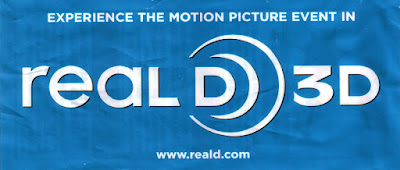
RealD Glasses Bag
It's been a long time since I've seen anything in 3D--almost since Captain EO 20 years ago. Naturally, I don't remember much about the red and blue experience. My wife says that it is much, much better.
Because I wear glasses, they pushed the 3D glasses farther down my nose. This, near as I can tell, caused any major motion to blur out. When I pressed my finger against the bridge of the glasses to keep them closer to my eyes the blurring seemed to go away. This definitely detracted from the smoothness of the digital projection and made the 3D aspect annoying at parts.
As for the movie?
Well, Pixar has done it again. Every trailer they release makes me scratch my head and say, "They're doing a movie about that?"
A movie about toys? What are they going to do with that lame plot?
A movie about monsters? What could they do with that?
A movie about fish? Come on: Boring!
A movie about cars? NASCAR? Are you serious?
A movie about a... trash robot?
A movie about a guy with balloons attached to his house and an annoying kid that tags along? Give me a break.
And every time--every time--the story is engaging, the world rich, and the topics they cover very moving and insightful. So definitely go see it, though it may not be worth the $13 when you will be able to get the special edition DVD for the cost of two tickets...
~Luke Holzmann
Your Media Production Mentor
5.13.2009
Equipment I Don't Have
Guess which of your favorites bloggers does not own a blowtorch:

Blowtorch
$630 is a big price tag, but I wouldn't have been able to do what he did. And it only took him a couple of hours and it was interesting to learn about all the latest things going on in the world of plumbing. And everything is working now.
I know what it's like to not have a ton of resources, but if you really want your productions to work it's probably worth a few bucks for someone with the tools and know-how to do it right.
~Luke Holzmann
Your Media Production Mentor
5.12.2009
Pay the Professionals
Like, my plumbing.

Plumbing
But over the years, I've learned one thing: Eventually I always have to call a plumber.
I've consoled myself with the knowledge that my snake was only 75' and the clog was over 100' down. I've rationalized that I don't own a scope and so couldn't see the breaks in the pipe. And I've come to accept the fact that when I try to fix things, sometimes they just break.
Like my most recent attempt.
The backflow unit outside my house finally broke, spraying water everywhere and completely eliminating my sprinkler's water pressure. It was old and now really needed to be replaced. I poked around online, compared prices, found it for relatively "cheap" at my local Lowes-Depot, and borrowed my parent's pipe wrenches. Sure, I don't like doing this kind of thing, but I can do it.
And so I started by simply unscrewing the current--broken--fixture from the system. It was really stuck on there. I guess the years had helped the system fuse together. After putting my weight into it and un-threading it about three turns, I stepped back to see what I had accomplished.
The copper pipe was now completely mangled.
I called the plumber the next day. Why? Because I don't have the tools, nor the patience, nor the expertise I need to get my sprinklers working again. And after talking to the plumber, I know what needs to be done and why.
The lesson: Sometimes it's best to hire a professional. As media producers we feel like we have to do it all. But it can make your production so much better if you get someone with the tools and the know-how to help you. It's the difference between good audio and bent pipes... and several hundred dollars.
~Luke Holzmann
Your Media Production Mentor
5.11.2009
Another DVD Coming?
This one is to cover "advanced math concepts," be shot only half days, and finish in a couple of months with about a month or so of pre-production.
I have my reservations.
Mostly notably: We don't have a clear picture of what this DVD is about. I was chatting with one of the producers today and he pointed to the Production Triangle I have hanging on my cube wall. I nodded and said, "But we don't even have an idea of what 'quality' means for this project. We don't know what it's supposed to look like in the end. And, honestly, we're not even sure about the amount of time we want to commit to this. So, we can't even talk about the Production Triangle yet because we don't have two of the points."
That's a huge problem.
After our chat he went to talk to one of the executive producers of the project.
We will see how this all pans out. If we're still green lit by the end of this week, I'll be meeting with the writer and director to talk over what we want to show in this DVD.
Ah, the world of production. Not too many dull moments <smile>.
~Luke Holzmann
Your Media Production Mentor
5.01.2009
Essential Gear: Ducky Bag
Eventually you'll have a bunch of C-47s you'll need to keep track of. And I've seen all sorts of methods: clipping them to your shirt/pants, tossing them into a general odds and ends box, filling up a special container, or just getting a new bag of them with each shoot.
My method is far more refined, professional, distinguished, and effective. In fact, I think it's obviously the best method out there. But first, some history:
Back in 2005, I was at nationals with my University's swim team. We were about to enter the highest level of competition of the year, and the girls on the team wanted to encourage us. So they made us little "goody bags" with odds ends to keep our spirits up.
This was especially important for me because the video camera strap had broken, so it was hard to hold the camera.

Video Camera
Well, this goody bag turned out to be incredibly useful. After removing the teddy bear, candy, commemorative Christmas ornament, and other odds and ends, I realized the bag was the perfect size to house my C-47s. And that is why, if you ever shoot with me, you will likely see this around the set:

Ducky Bag
I highly recommend you get something similar.
It's the sign of a true professional.
~Luke Holzmann
Your Media Production Mentor
4.30.2009
The Pelican Brief...case
Pelican won, hands down.
And they've got a great tagline/guarantee: You break it, we replace it... forever.
And, what was more, the case was a great price too.
So if you're ever looking for a good hard case to lug... whatever around, check them out.

My Pelican Case
Not surprisingly, I don't have many picture of my camera case "in action." I'll need to work on that next time we do a shoot.
~Luke Holzmann
Your Media Production Mentor
4.29.2009
Microsoft IE Errors
I'm much more of a Firefox/Chrome kind of guy.
But for as infuriating and lame as IE is, it is excellent for showing you problems with your site. Granted, many problems are due to IE's problematic rendering of code, so set those issues aside for a moment. The reality is this: Twice in the recent months, I have come across errors on my page that only IE displayed that proved to be at the code level. In other words: There was a problem with my code, and IE was the only browser to tell me.
For instance, the page looked great in Firefox, Chrome, and Safari, but IE had my text getting smaller and smaller at the bottom of one of my pages. Something like:
Small
smaller
smallest
Once I saw the problem in IE, I instantly knew that I had missed a </sup> tag, and was able to fix the problem in no time. But had I stuck with Firefox only, the problem would still exist.
Someone may object and say: But if the other browsers show what you want, who cares if the code is wrong?
Well: 1. Sloppy/wrong code is not good and can lead to bigger issues. 2. What if, in the future, I actually wanted a dual <sup> tag and the browser wouldn't let me? It quickly becomes problematic when your computer/application starts thinking for you.
So remember: As frustrating as it can be, check your site on IE.
You may just find an error that you wouldn't have seen otherwise.
Of course, you may not. There's still something odd with one my blogs in IE, and I have no idea why.
~Luke Holzmann
Your Media Production Mentor
4.28.2009
Editing Online

Jumpcut Closing
This interests me because web-based media is predicted to be huge. There's a bunch of people saying that web delivery will soon outstrip even Blu-ray. More and more image manipulation options are available online, and Flash-based applications are becoming pretty big. This is to say nothing of the many free video hosting sites available. So to see a moderately viable video option go away is interesting.
~Luke Holzmann
Your Media Production Mentor
